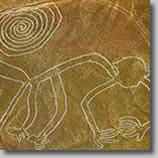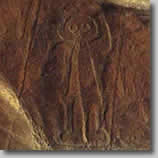Nazca Lines Facts
There are many interesting and unknown facts about the Nazca lines in Peru and on this page we aim to enlighten you on all the facts you need to know on the Nazca Lines and surrounding areas.

>>The Nazca Lines were created in the time of the Nazca Indians, who flourished in the area from 200BC to around 600AD. Graves and ruins of their settlement have been found near the lines after the rediscovery of the Nazca lines in 1939 by American scientist Paul Kosok.
>>The area of the Peruvian desert in which the Nazca Lines were drawn is called the Pampa Colorada. It is 15 miles wide and runs some 37 miles parallel to the Andes and the Pacific Ocean.
>>The desert is not sandy, but made of dark red surface stones and soil with lighter-colored subsoil beneath. The Lines were created by clearing away the darker upper layer to reveal the lighter subsoil.
>>Some of the Nazca lines are over 6 miles long in cases and can only be appreciated in their true magnificence by viewing the lines form the air, as often this is the only way to view the complete Nazca line depictions of monkeys, birds, spiders, hummingbirds, lizards and fish all present on the desert floor.
For Photos of the Nazca Lines Please Click Here

>> The reason for the Nazca lines remaining so prevalent on the floor of the desert is also due to the conditions within their region, this is due to the desert being extremely dry with little wind, rain and a continual temperature of arond 25°C (77°F) for the whole calendar year.
>>The Nazca lines are featured in the book "Chariots of the Gods" by Erich Von Däniken that discusses his belief that the Nazca lines were created by aliens and used as landing strips. He felt that the designs were to complex and covered such a large distance that they could not have been created by humans due to the size of the lines, lack of tools plus they had no ability to view the lines from the air.
For More Information on the Chariots of the Gods Please Click Here

